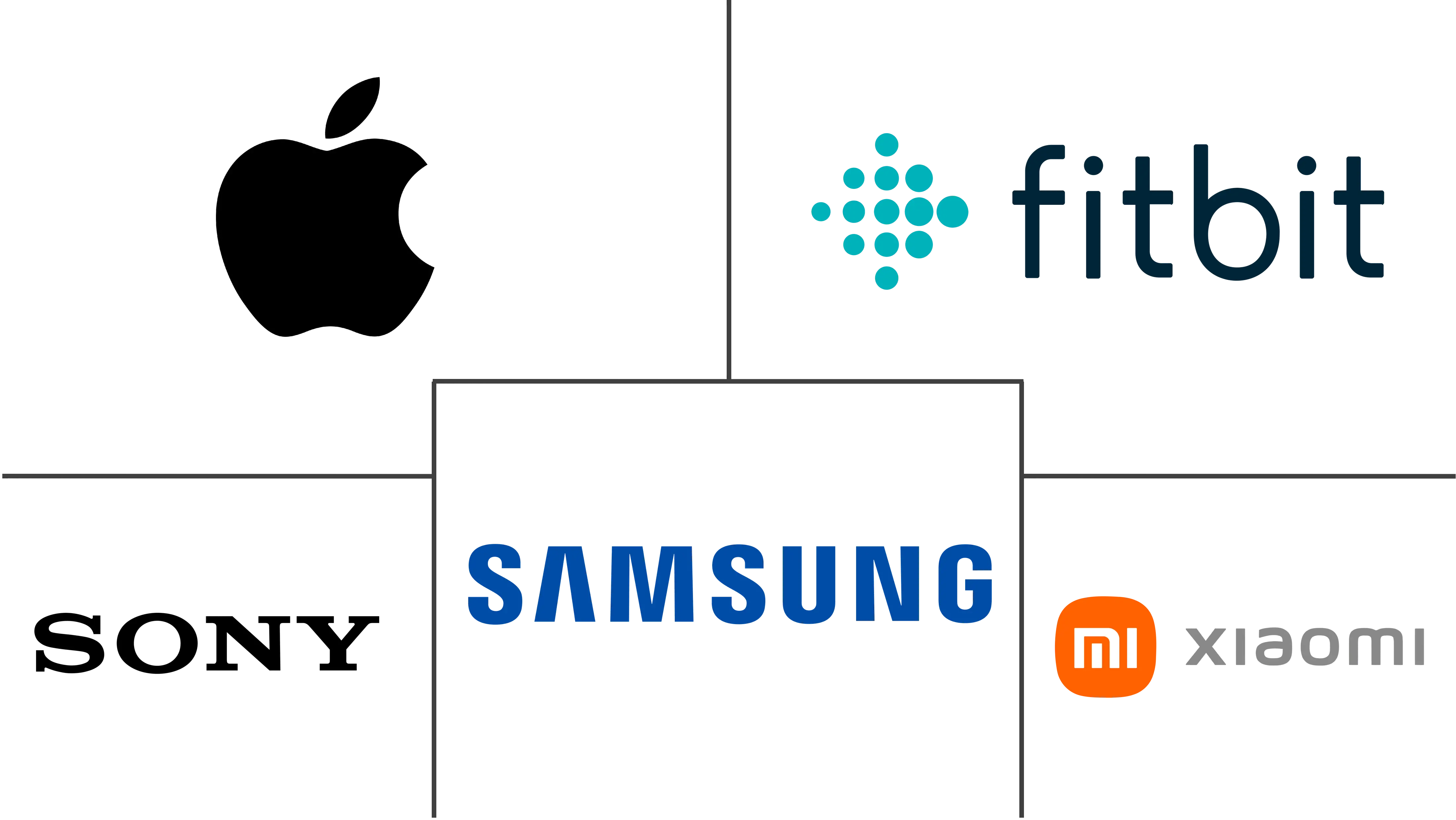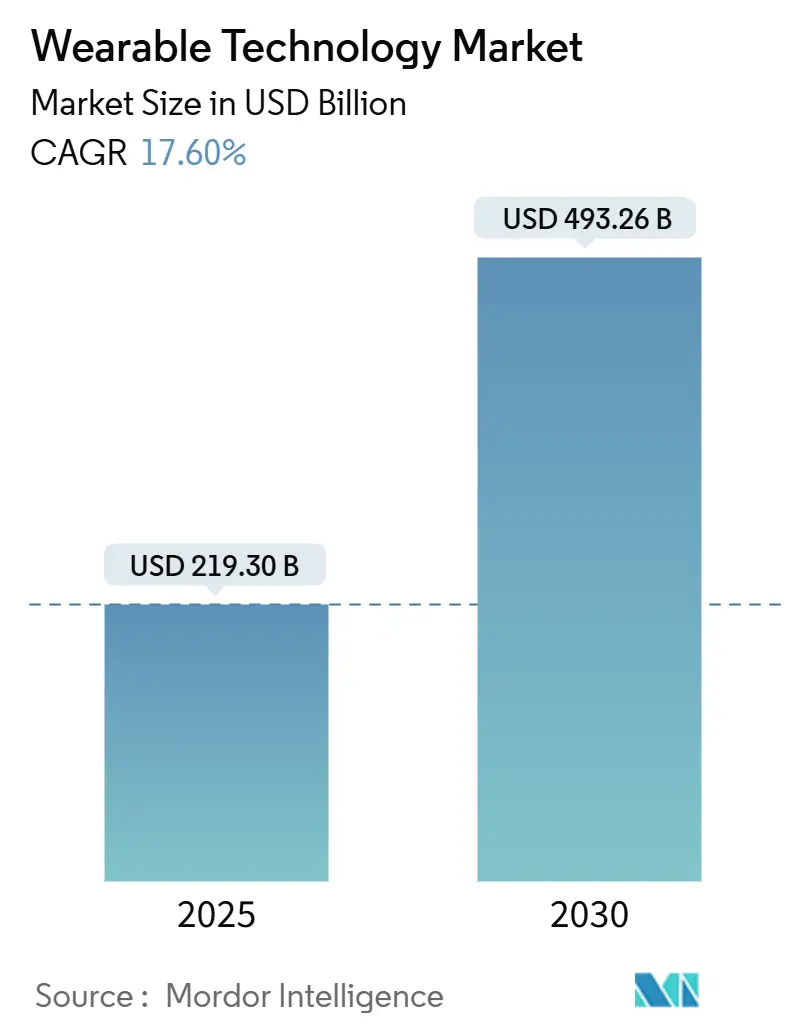
Wearable Technology Market Analysis by Mordor Intelligence
The Wearable Technology Market size is estimated at USD 219.30 billion in 2025, and is expected to reach USD 493.26 billion by 2030, at a CAGR of 17.60% during the forecast period (2025-2030).
underscoring the sector’s rapid scale-up and the commercial viability of sensor-rich connected devices.[1]U.S. Food and Drug Administration, “Digital Health Center of Excellence,” fda.gov Momentum stems from FDA clearances for AI-enabled medical wearables, enterprise spending on augmented reality headsets, and solid-state battery breakthroughs that ease long-standing power-density constraints. North America accounts for the largest revenue pool, yet Asia-Pacific is expanding the fastest as component manufacturing localizes and governments digitize healthcare delivery. Device leadership remains with smartwatches, although head-mounted displays record the steepest uptake, buoyed by frontline workforce deployments. Competition has shifted from hardware differentiation to ecosystem control; the companies that integrate chips, software, and services most tightly are capturing a disproportionate share of value.
Key Report Takeaways
- By device type, smartwatches led with 46% of the wearable technology market share in 2024, while head-mounted displays are projected to grow at a 19.51% CAGR to 2030.
- By component, sensors commanded 29% of the wearable technology market size in 2024, whereas solid-state batteries are set to expand at a 20.22% CAGR through 2030.
- By connectivity technology, Bluetooth and BLE held 62% share of the wearable technology market size in 2024; cellular 5G is advancing at a 19.21% CAGR during the outlook period.
- By end-user industry, consumer electronics generated 58% of 2024 revenue, yet healthcare applications are pacing the field with a 20.55% CAGR to 2030.
- By geography, North America captured 32% of 2024 revenue, while Asia-Pacific is forecast to post a 20.80% CAGR over 2025-2030.
Global Wearable Technology Market Trends and Insights
Drivers Impact Analysis
| Driver | (~) % Impact on CAGR Forecast | Geographic Relevance | Impact Timeline |
|---|---|---|---|
| AI-enabled clinical-grade sensors | +3.20% | Global, with early adoption in North America and EU | Medium term (2-4 years) |
| Enterprise AR for frontline workforce | +2.80% | North America and EU, expanding to APAC | Short term (≤ 2 years) |
| Reimbursement inclusion for medical wearables | +2.10% | North America and EU regulatory frameworks | Medium term (2-4 years) |
| Edge AI and low-power chipsets | +2.40% | Global, led by APAC manufacturing hubs | Long term (≥ 4 years) |
| Solid-state micro-batteries | +1.90% | Global, with APAC production leadership | Long term (≥ 4 years) |
| Immersive gaming and e-sports demand | +1.60% | Global, concentrated in developed markets | Short term (≤ 2 years) |
| Source: Mordor Intelligence | |||
AI-Enabled Clinical-Grade Sensors
Regulators continue to fast-track AI-driven biosensors, positioning wearables as decision-support tools in preventive medicine. FDA’s Digital Health Center of Excellence has streamlined review pathways, and innovators such as Trinity Biotech have launched continuous glucose monitors that fuse metabolic data with predictive analytics.[2]Fred Pennic, “Trinity Biotech Unveils CGM+,” HIT Consultant, hitconsultant.net Academic groups at KAIST and the University of Hong Kong are commercializing cuff-less blood-pressure modules and organic transistor arrays that process data locally, reducing latency and safeguarding privacy. These advances narrow the gap between consumer fitness gadgets and clinical diagnostics, giving payers confidence to reimburse remote monitoring services. Hospitals view the technology as a route to earlier intervention and cost avoidance, further enlarging the addressable base for the wearable technology market.
Enterprise AR for Frontline Workforce
Industrial augmented reality headsets improve efficiency in hazardous or distributed settings. Colgate-Palmolive logged 63 virtual collaborations that trimmed travel expenses and downtime, while Shell deployed intrinsically safe AR wearables across 12 countries to support maintenance in explosive zones.[3]RealWear, “Colgate-Palmolive Case Studies,” realwear.com Fujitsu cut assembly tasks by 19% after integrating AR guidance, and steelmaker KSP achieved 40% productivity gains through helmet-mounted visualization. The payback period often falls below one year, making procurement straightforward for operations teams. As remote-expert applications expand, enterprises are ordering at scale, propelling the wearable technology market.
Reimbursement Inclusion for Medical Wearables
U.S. insurers now reimburse remote physiologic and therapeutic monitoring when FDA-cleared devices are prescribed, lowering out-of-pocket costs for patients with chronic conditions. FDA’s over-the-counter approval of the Stelo glucose system and De Novo clearance for OsteoBoost therapeutic vibration illustrate a policy shift toward consumer-directed medical devices. CPT codes for remote monitoring remove billing friction and catalyse physician adoption. In Europe, similar reimbursement pilots are underway, signalling wider acceptance of wearables as legitimate clinical interventions that enlarge the wearable technology market.
Edge AI and Low-Power Chipsets
Qualcomm’s Snapdragon AR1+ packs on-device neural processing that eliminates reliance on smartphones, while Atmosic and AONDevices cut radio power draw by validating sensor events before transmission.[4]Samuel Reed, “The Wearable AI Revolution,” AInvest, ainvest.com Eatron’s AI battery management raises usable capacity by 10%, and Samsung’s 3 nm Exynos W1000 boosts performance-per-watt by 20%. These breakthroughs extend runtimes and enable always-on features without bulkier batteries, a key buying criterion for consumers. The marriage of edge AI and power-efficient silicon, therefore, sustains high growth in the wearable technology market.
Restraints Impact Analysis
| Restraint | (~) % Impact on CAGR Forecast | Geographic Relevance | Impact Timeline |
|---|---|---|---|
| Data-privacy compliance burden | -1.80% | EU GDPR, expanding globally | Medium term (2-4 years) |
| Advanced-packaging supply bottlenecks | -1.40% | Global, concentrated in APAC supply chains | Short term (≤ 2 years) |
| E-waste and sustainability pressure | -1.10% | EU WEEE directive, spreading to other regions | Long term (≥ 4 years) |
| User fatigue / device abandonment | -2.20% | Global consumer markets | Short term (≤ 2 years) |
| Source: Mordor Intelligence | |||
Data-Privacy Compliance Burden
Wearables harvest biometrics that fall under stringent rules such as GDPR and Illinois BIPA. Manufacturers must embed consent management and on-device anonymization, raising development costs and delaying launch schedules. Cross-border data-transfer limits further complicate cloud analytics. Small vendors lacking legal resources face a higher cost-of-compliance hurdle, tempering new-entry rates and trimming growth for the wearable technology market.
User Fatigue and Device Abandonment
Surveys show 29-30% of users stop wearing smartwatches within six months, often citing battery life, comfort, or unclear value. Longitudinal data reveal engagement drops to 16% after 320 days as novelty fades. Unless vendors deliver actionable insights instead of raw metrics, churn will persist, shaving points off the wearable technology market’s CAGR.
Segment Analysis
By Device Type: Smart Glasses Drive Next-Generation Computing
Head-mounted displays posted the fastest 19.51% CAGR over 2025-2030, yet smartwatches retained the largest 46% slice of the wearable technology market share in 2024. This momentum lifts the overall wearable technology market as enterprises adopt hands-free displays for maintenance, training, and logistics. Meta sold 2 million Ray-Ban smart glasses since late 2023 and is scaling to 10 million units annually, validating consumer appetite for discreet eyewear. Google’s USD 150 million partnership with Warby Parker expands style options, lowering the fashion barrier to adoption.
Diversification is also visible in ear-wearables, where Apple patents point to in-ear health diagnostics that could reduce reliance on wrist devices. Although smart clothing remains nascent, Johns Hopkins’ fiber batteries hint at washable energy storage that could mainstream e-textiles. Wristbands risk commoditization as smartwatch ASPs fall, but neural-input bands maintain niche demand for AR control. Collectively, these shifts enrich the wearable technology market.
Second-generation smart glasses integrate cellular radios and micro-LED displays, allowing notification triage, navigation overlays, and real-time translation without tethering to phones. OEMs focus on weight reduction and prescription-lens support to widen the addressable audience. The category’s rapid scale will keep device diversity high, ensuring the wearable technology market continues to grow.
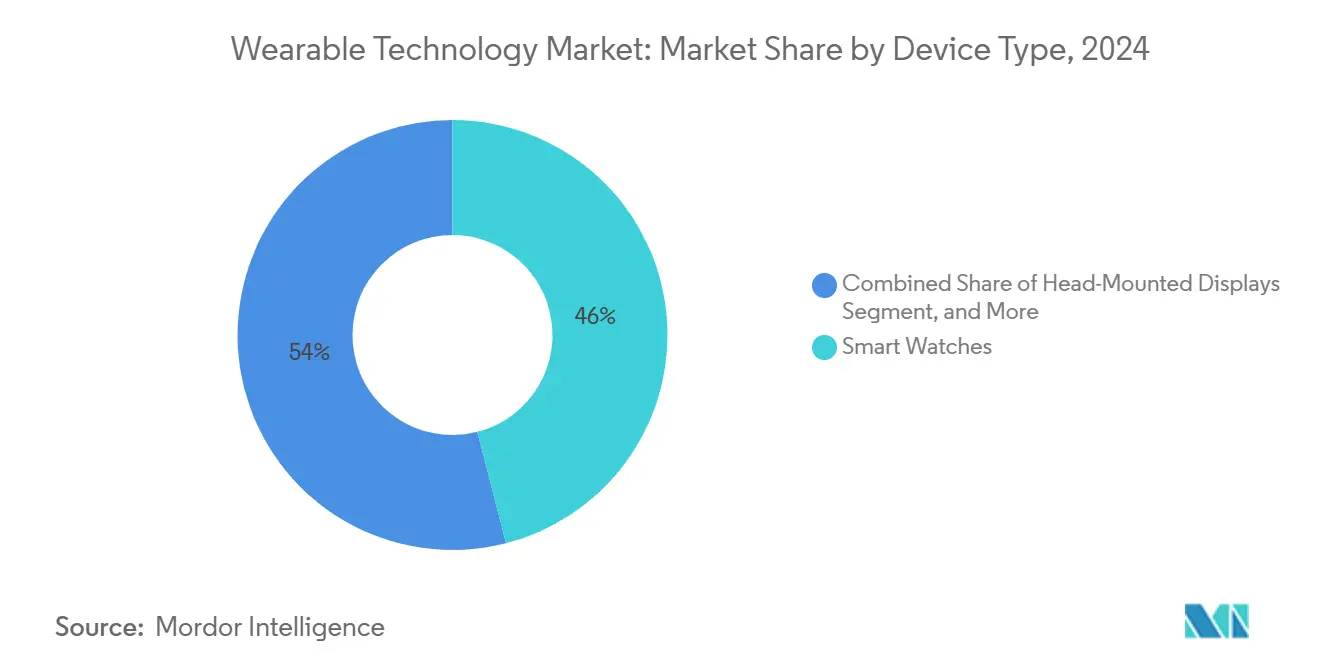
Note: Segment shares of all individual segments available upon report purchase
By Component: Solid-State Batteries Enable Form Factor Innovation
Sensors captured the largest 29% contribution to the wearable technology market size in 2024, reflecting the need for multi-modal data streams. At the same time, solid-state batteries are forecast to outpace all components with a 20.22% CAGR, providing the energy foundation for advanced use cases. TDK’s chip-scale cells and Samsung’s week-long prototypes illustrate how safer chemistries unlock slimmer enclosures. Processors and memory ride the 3D-stacking wave, with TSMC planning panel-level packaging that blends CPUs, GPUs, and memory on a single substrate.
Displays are shifting to flexible OLED and micro-LED formats, enabling curved and transparent surfaces that merge with eyewear. Connectivity ICs co-package Bluetooth, Wi-Fi, and UWB to simplify board layouts and shrink antenna footprints. Software and services represent the highest margin layer, and platform owners increasingly gate features behind subscriptions, cementing ecosystems and elevating switching costs. Both margin pools and unit volumes, therefore, continue to widen for the wearable technology market.
By Connectivity Technology: 5G Cellular Enables Standalone Operation
Bluetooth Low Energy retained a dominant 62% share of the wearable technology market size in 2024 because of its efficiency for constant sensor streaming. Yet 5G modules will record the sharpest 19.21% CAGR, driven by consumer desire for phone-free experiences on hikes, runs, or worksites. Apple’s LTE/5G watches demonstrate a willingness to pay for autonomy, but battery stamina curbs always-connected sessions. Qualcomm’s AR1+ solves part of that dilemma via low-power radios selectable in real time.
NFC and UWB adoption rise as contactless payment and indoor navigation use cases multiply. Satellite and LP-WAN modems target safety beacons and asset tracking in remote areas. Wi-Fi remains necessary for software updates, though power constraints limit duty cycles. The expansion of multi-protocol chipsets underpins best-of-both-worlds architectures that elevate user experience and sustain the wearable technology market.
By End-User Industry: Healthcare Drives Premium Adoption
Consumer electronics still account for 58% of revenue, but healthcare devices will grow at a 20.55% CAGR through 2030 as payers reimburse more indications. Dexcom’s USD 75 million stake in Oura links glucose data with sleep and stress metrics to build a full metabolic dashboard. FDA’s green light for automated insulin dosing in type 2 diabetes widens the pool of eligible patients. Cardiology is another hotspot; WearLinq’s 6-lead ECG patch brings hospital-grade diagnostics to outpatient settings.
Industrial and enterprise buyers deploy AR headsets to slash training time and prevent errors. Defense agencies demand rugged wearables capable of running classified apps offline. Across sectors, premium pricing is secured when devices deliver quantifiable outcomes, whether medical cost avoidance or productivity gains, fuelling the expansion of the wearable technology market.
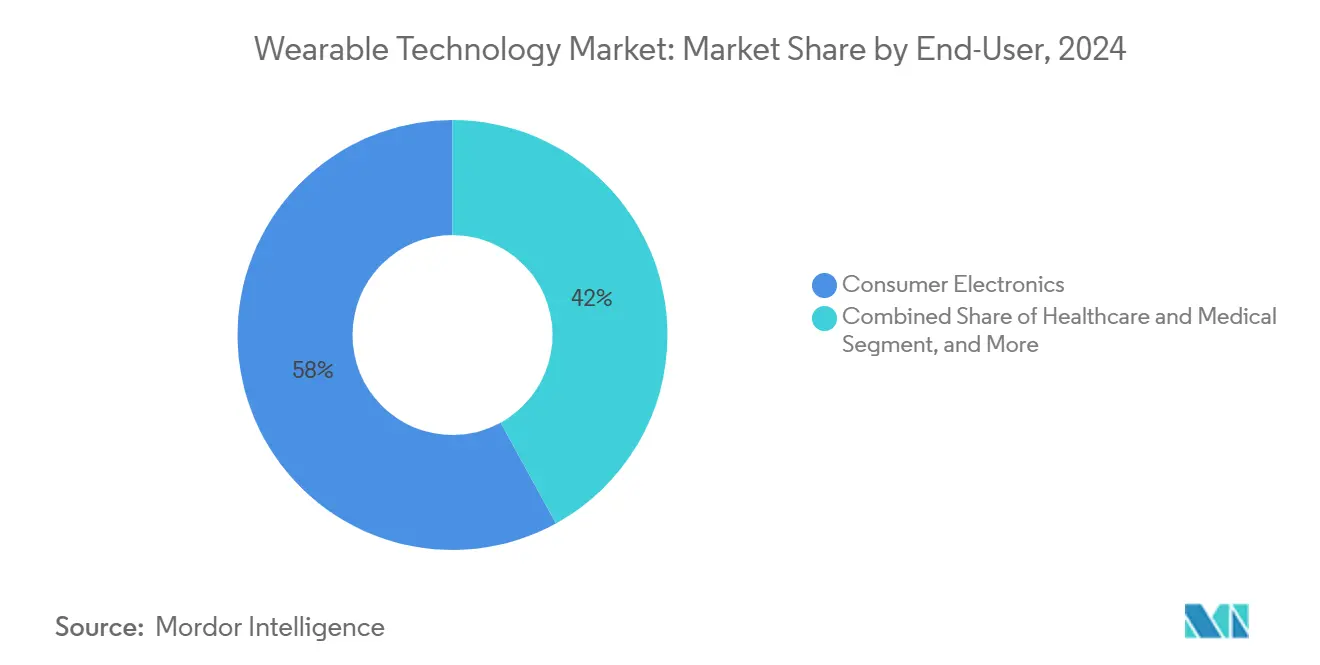
Note: Segment shares of all individual segments available upon report purchase
By Connectivity Technology: Multi-Protocol Architectures Optimize Performance
Market leaders now embed Bluetooth, Wi-Fi, cellular 5G, NFC, UWB, and satellite links on one board. Dynamic switching selects the lowest-energy path that still meets bandwidth needs. The concept boosts average device ASP while maintaining battery life and is rapidly becoming a standard expectation among professional and fitness users. Qualcomm’s integrated approach is setting a reference design that tier-two OEMs follow, reinforcing the pace of growth across the wider wearable technology market.
Geography Analysis
North America generated 32% of 2024 revenue, reflecting R&D leadership, venture funding depth, and favourable reimbursement policy. The FDA authorized 124 novel devices in 2023, its highest annual total, shortening commercialization timelines. Enterprise AR pilots run by U.S. multinationals contribute to steady hardware refresh cycles. Nonetheless, elevated abandonment rates reveal ongoing gaps in consumer onboarding and value delivery.
Asia-Pacific is projected to expand at a 20.80% CAGR over 2025-2030, making it the primary volume engine for the wearable technology market. China’s policy support for digital health and Korea’s leadership in 3 nm foundry and solid-state batteries accelerate regional supply-chain self-sufficiency. India’s fitness-aware middle class and Japan’s aging population further stretch demand curves. TSMC’s new fabs in Arizona and Kumamoto add resilience yet keep key process know-how in the region.
Europe balances strict privacy and sustainability rules with strong industrial automation demand. GDPR and the WEEE directive increase compliance burden but also create competitive moats for vendors with robust governance. Germany’s smart-factory programs and the U.K.’s National Health Service pilots on remote monitoring offer stable enterprise pipelines. Smaller markets in the Middle East, Africa, and South America trail in infrastructure and discretionary income, yet they represent option value as connectivity costs fall, and local app ecosystems mature.
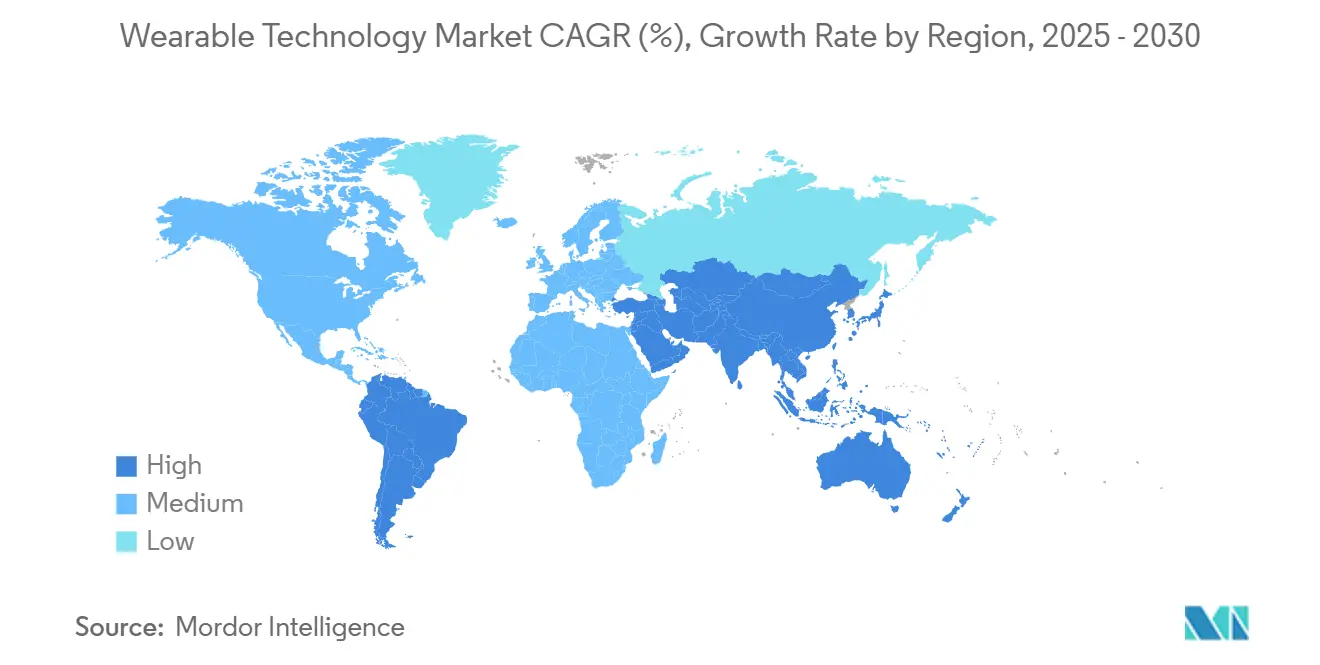
Competitive Landscape
The sector shows moderate concentration: the top five vendors collectively account for roughly 62% of revenue, yielding a score of 6 on the market concentration scale. Apple posted USD 7.5 billion in wearables revenue in Q2 2025, illustrating the power of device-plus-service bundling. Samsung’s KRW 79.14 trillion quarter confirms its strength in multi-device ecosystems. Meta invested USD 3.5 billion in EssilorLuxottica, securing optical expertise for smart glasses, while Google aligned with Warby Parker to broaden distribution.
Patent filings spotlight hand-gesture recognition, low-power sensing, and federated learning, signalling where differentiation may lie over the next cycle. New entrants concentrate on smart rings and neural interface bands, attacking whitespace not fully addressed by incumbents. Component suppliers such as TDK, Qualcomm, and TSMC gain bargaining power as their technologies become critical to form-factor evolution. Overall, sustained R&D outlays and ecosystem lock-in remain the primary defensive walls in the wearable technology market.
Wearable Technology Industry Leaders
-
Apple Inc.
-
Samsung Group
-
Xiaomi Inc.
-
Fitbit Inc.
-
Sony Corporation
- *Disclaimer: Major Players sorted in no particular order
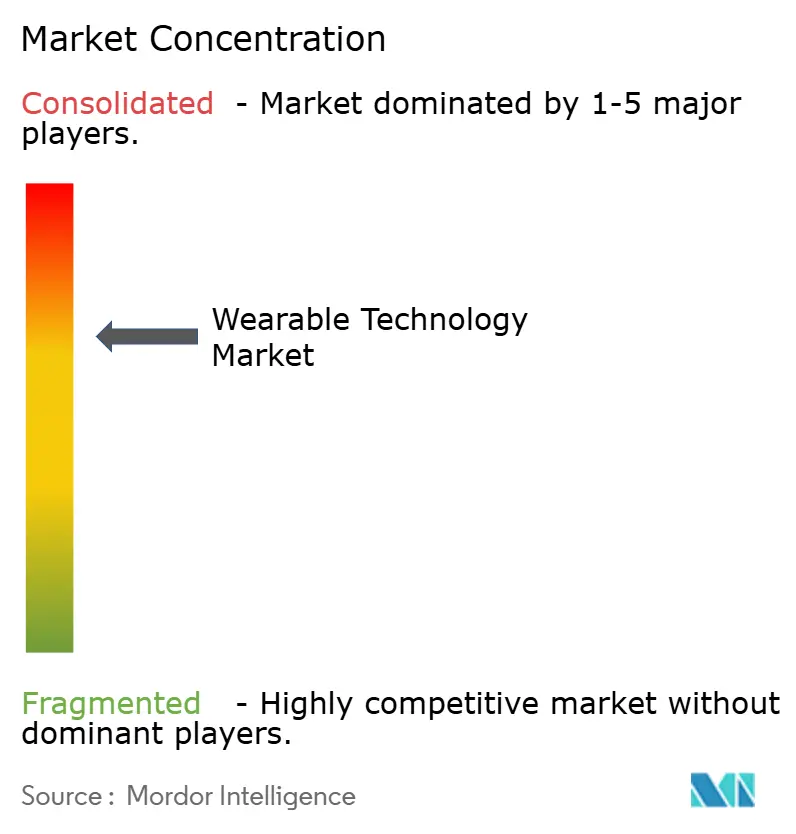
Recent Industry Developments
- July 2025: Amazon acquired Bee to advance AI-centric wearables, marking its formal entry into the device category.
- July 2025: Trinity Biotech launched CGM+ AI native biosensor for holistic metabolic monitoring.
- May 2025: Google committed USD 150 million to Warby Parker, Kering Eyewear, and Gentle Monster to co-develop smart glasses.
- May 2025: Google and Samsung showed AI smart-glasses prototypes with Gemini onboard translation at I/O 2025.
Global Wearable Technology Market Report Scope
Wearable technology is an emerging trend that integrates electronics into daily activities, fits into changing lifestyles, and can be worn on any body part. The main thing that makes wearable technology possible is the ability to connect to the internet and exchange data between a network and a device.
The wearable technology market is segmented by type of device (smartwatches, head-mounted displays, smart clothing, wristbands, ear-wearables, and other device types) and geography. The study also incorporates a country-level analysis. The market sizes and forecasts are provided in terms of value (USD) for all the above segments.
| Smart Watches |
| Ear-wearables |
| Head-Mounted Displays |
| Smart Clothing |
| Wristbands |
| Processors and Memory |
| Sensors |
| Displays |
| Batteries |
| Connectivity ICs |
| Software and Services |
| Bluetooth and BLE |
| Cellular (LTE/5G) |
| Wi-Fi |
| NFC and UWB |
| Satellite and LP-WAN |
| Consumer Electronics |
| Healthcare and Medical |
| Industrial and Enterprise |
| Defense and Public Safety |
| North America | United States |
| Canada | |
| Mexico | |
| Europe | United Kingdom |
| Germany | |
| France | |
| Italy | |
| Rest of Europe | |
| Asia-Pacific | China |
| Japan | |
| India | |
| South Korea | |
| Rest of Asia | |
| Middle East | Israel |
| Saudi Arabia | |
| United Arab Emirates | |
| Turkey | |
| Rest of Middle East | |
| Africa | South Africa |
| Egypt | |
| Rest of Africa | |
| South America | Brazil |
| Argentina | |
| Rest of South America |
| By Device Type | Smart Watches | |
| Ear-wearables | ||
| Head-Mounted Displays | ||
| Smart Clothing | ||
| Wristbands | ||
| By Component | Processors and Memory | |
| Sensors | ||
| Displays | ||
| Batteries | ||
| Connectivity ICs | ||
| Software and Services | ||
| By Connectivity Technology | Bluetooth and BLE | |
| Cellular (LTE/5G) | ||
| Wi-Fi | ||
| NFC and UWB | ||
| Satellite and LP-WAN | ||
| By End-User Industry | Consumer Electronics | |
| Healthcare and Medical | ||
| Industrial and Enterprise | ||
| Defense and Public Safety | ||
| By Geography | North America | United States |
| Canada | ||
| Mexico | ||
| Europe | United Kingdom | |
| Germany | ||
| France | ||
| Italy | ||
| Rest of Europe | ||
| Asia-Pacific | China | |
| Japan | ||
| India | ||
| South Korea | ||
| Rest of Asia | ||
| Middle East | Israel | |
| Saudi Arabia | ||
| United Arab Emirates | ||
| Turkey | ||
| Rest of Middle East | ||
| Africa | South Africa | |
| Egypt | ||
| Rest of Africa | ||
| South America | Brazil | |
| Argentina | ||
| Rest of South America | ||
Key Questions Answered in the Report
What is the projected value of the wearable technology market in 2030?
The sector is expected to reach USD 493.26 billion by 2030 at a 17.60% CAGR.
Which region will grow the fastest through 2030?
Asia-Pacific is forecast to expand at a 20.80% CAGR, outpacing all other regions.
Which device category currently holds the largest revenue?
Smartwatches maintained a 46% share in 2024, the highest among all device types.
Why are solid-state batteries important for future devices?
They offer higher energy density and improved safety, enabling thinner designs and week-long runtimes.
How are insurers influencing adoption?
Reimbursement policies now cover FDA-cleared wearables for chronic-disease management, lowering patient costs and boosting uptake.
What factor most limits long-term consumer usage?
User fatigue and perceived lack of ongoing value drive abandonment rates of nearly 30% within six months.
Page last updated on:
